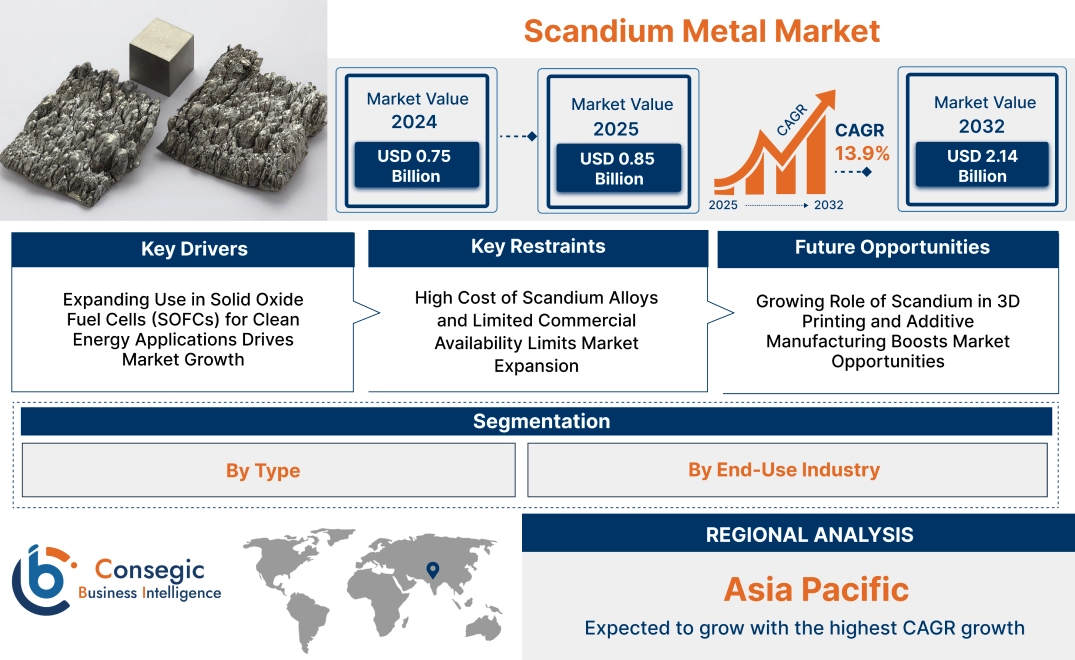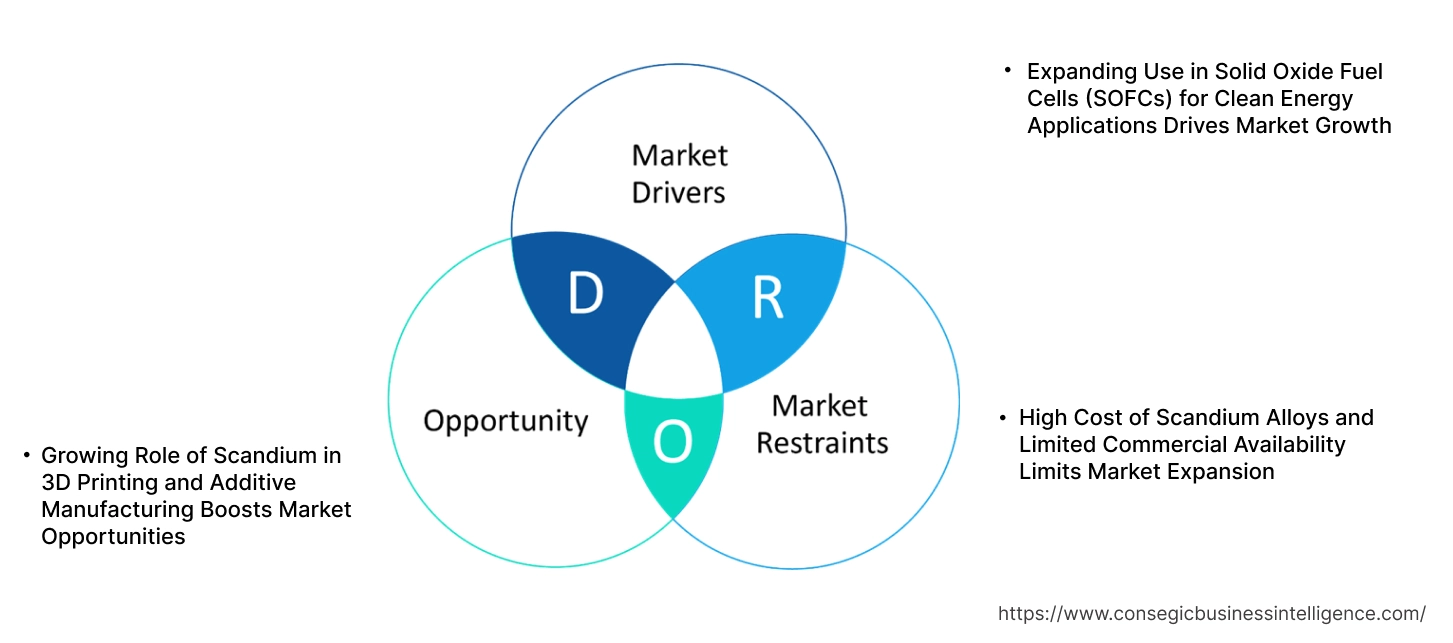- Summary
- Table Of Content
- Methodology
Scandium Metal Market Size:
Scandium Metal Market size is estimated to reach over USD 2.14 Billion by 2032 from a value of USD 0.75 Billion in 2024 and is projected to grow by USD 0.85 Billion in 2025, growing at a CAGR of 13.9% from 2025 to 2032.
Scandium Metal Market Scope & Overview:
Scandium metal is a rare earth element known for its lightweight nature, high strength, and corrosion resistance. It enhances the mechanical properties of aluminum alloys, improving durability and reducing weight in structural applications. Its conductivity and stability also make it suitable for solid oxide fuel cells and advanced ceramic production.
Key features include excellent heat resistance, low density, and superior weldability. When alloyed with aluminum, it increases strength while maintaining formability, benefiting industries that require high-performance materials. Its compatibility with modern fabrication techniques ensures efficient integration into specialized applications.
Aerospace, defense, and electronics industries utilize scandium metal for its structural and functional advantages. Ongoing material innovations continue to optimize its performance, supporting the development of lightweight, high-strength components for advanced engineering applications.
Key Drivers:
Expanding Use in Solid Oxide Fuel Cells (SOFCs) for Clean Energy Applications Drives Market Growth
Scandium-stabilized zirconia enhances ionic conductivity and thermal stability, making SOFCs more efficient and durable. These fuel cells play a crucial role in reducing carbon emissions and providing long-term renewable energy solutions. Industries such as data centers, healthcare facilities, and remote power stations are adopting SOFC technology for its high efficiency and low environmental impact. Government policies promoting sustainable energy sources and hydrogen-based technologies are further strengthening the demand for scandium-enhanced SOFCs. With continuous advancements in fuel cell performance and cost reduction strategies, scandium's role in energy storage and distributed power systems is expected to expand. These factors are set to contribute significantly to scandium metal market expansion, reinforcing its importance in the transition to clean energy.
Key Restraints:
High Cost of Scandium Alloys and Limited Commercial Availability Limits Market Expansion
Scandium is primarily extracted as a byproduct of uranium and titanium mining, making its supply chain unpredictable and expensive. The lack of large-scale dedicated scandium mining operations results in low production volumes and high material costs, restricting its use to specialized industries such as aerospace and defense. Additionally, manufacturing scandium-aluminum alloys requires advanced metallurgical processes, further increasing production costs. Many industries opt for cheaper alternative alloys, such as titanium or magnesium-based materials, reducing the market share of scandium alloys. Without significant investments in cost-efficient extraction technologies and scalable refining processes, commercial adoption remains constrained. Overcoming these cost barriers and improving accessibility will be essential for driving scandium metal market growth, ensuring broader industrial applications.
Future Opportunities:
Growing Role of Scandium in 3D Printing and Additive Manufacturing Boosts Market Opportunities
Scandium significantly improves the printability, strength, and corrosion resistance of aluminum powders used in aerospace, automotive, and industrial components. The growth of additive manufacturing is enabling industries to produce customized, complex designs with reduced material waste, making scandium an ideal element for high-precision engineering applications. Additionally, advancements in powder metallurgy and laser sintering technologies are expanding the feasibility of scandium-based materials in structural and functional applications. As industries seek cost-effective and durable 3D printing materials, scandium-infused alloys are gaining traction for prototyping, lightweight structural components, and high-temperature applications.
- For instance, in February 2025, Scandium Canada released updates on the aluminum-scandium alloys and powders research and development, which are designed specifically for additive manufacturing purposes. The successfully printed test coupons are expected to be tested for mechanical strength with and without heat tempering.
These developments are expected to drive scandium metal market opportunities, positioning it as a key material in the next generation of industrial and aerospace manufacturing technologies.
Scandium Metal Market Segmental Analysis :
By Type:
By type, the market is segmented into oxide, fluoride, chloride, nitrate, iodide, alloy, and others.
The alloy segment held the largest scandium metal market share in 2024.
- Scandium alloys are widely used in aerospace, automotive, and high-performance industrial applications, ensuring their dominance in the market.
- The need for lightweight, high-strength metal alloys is increasing, particularly in fuel-efficient and next-generation manufacturing.
- Scandium metal market analysis highlights that scandium-aluminum alloys improve corrosion resistance and durability, making them an attractive choice for multiple industries.
- As per market trends, research into advanced alloys is expanding, enhancing their role in energy-efficient and structural applications.
The oxide segment is expected to experience the fastest CAGR during the forecast period.
- Scandium oxide is widely used in solid oxide fuel cells (SOFCs), electronic ceramics, and optical coatings, driving its demand across various industries.
- The need for scandium oxide as a key material in energy storage and high-temperature applications is increasing as industries shift toward sustainable energy solutions.
- Market trends suggest that its role in advanced electronics and clean energy technologies is driving its adoption.
- Therefore, with increasing investment in renewable energy and high-performance materials, this segment is contributing to scandium metal market growth.
By End-Use Industry:
By end-use industry, the market is segmented into automotive & transportation, aerospace & defense, electronics & semiconductors, energy & power, manufacturing & industrial, medical & healthcare, and others.
The aerospace & defense segment held the largest scandium metal market share of 31.60% in 2024.
- Scandium is extensively used in lightweight aircraft structures, high-performance defense materials, and next-generation space technology.
- The need for high-strength, corrosion-resistant metals is rising, particularly in military and commercial aircraft manufacturing.
- Segmental analysis highlights the role of scandium-aluminum alloys in reducing aircraft weight and improving fuel efficiency.
- As per scandium metal market trends, increasing investments in defense innovation and space exploration are further driving scandium demand.
The energy & power segment is anticipated to experience the fastest CAGR during the forecast period.
- Scandium plays a critical role in solid oxide fuel cells (SOFCs), enabling efficient power generation and energy storage.
- The need for scandium-based materials in clean energy applications is increasing as governments and industries focus on renewable energy and carbon-neutral technologies.
- Market trends suggest that advancements in fuel cell technology are expanding the potential for scandium usage in sustainable energy production.
- Thus, with the transition to cleaner and more efficient power solutions, this segment is driving scandium metal market expansion.
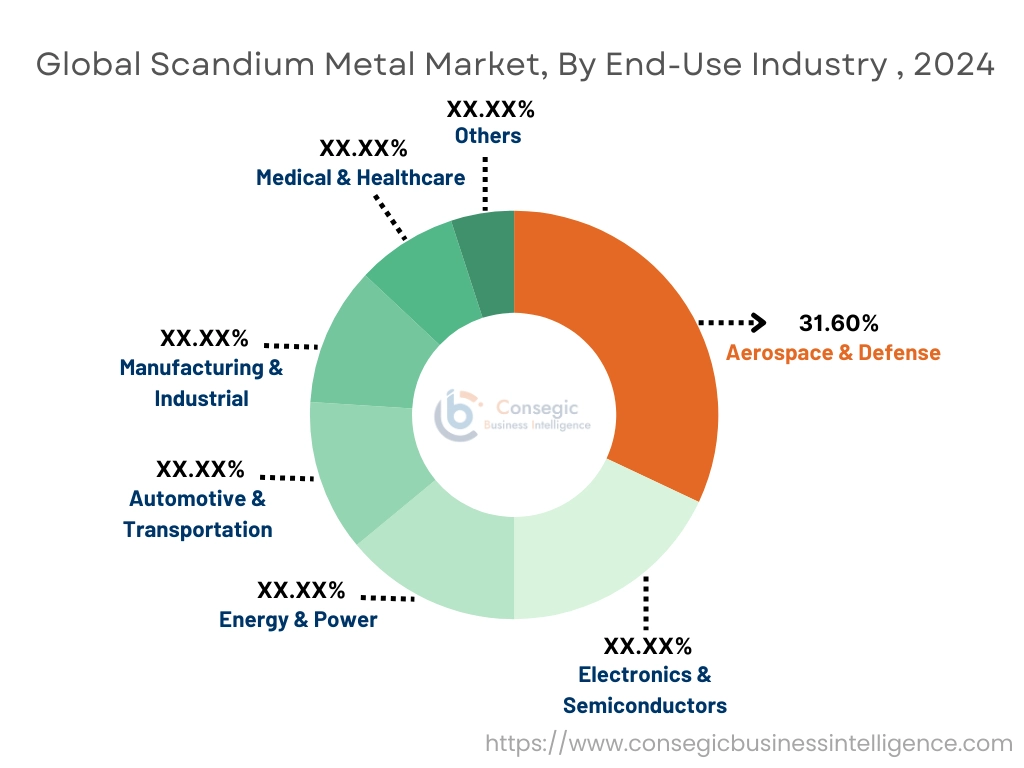
Regional Analysis:
The regions covered are North America, Europe, Asia Pacific, the Middle East and Africa, and Latin America.
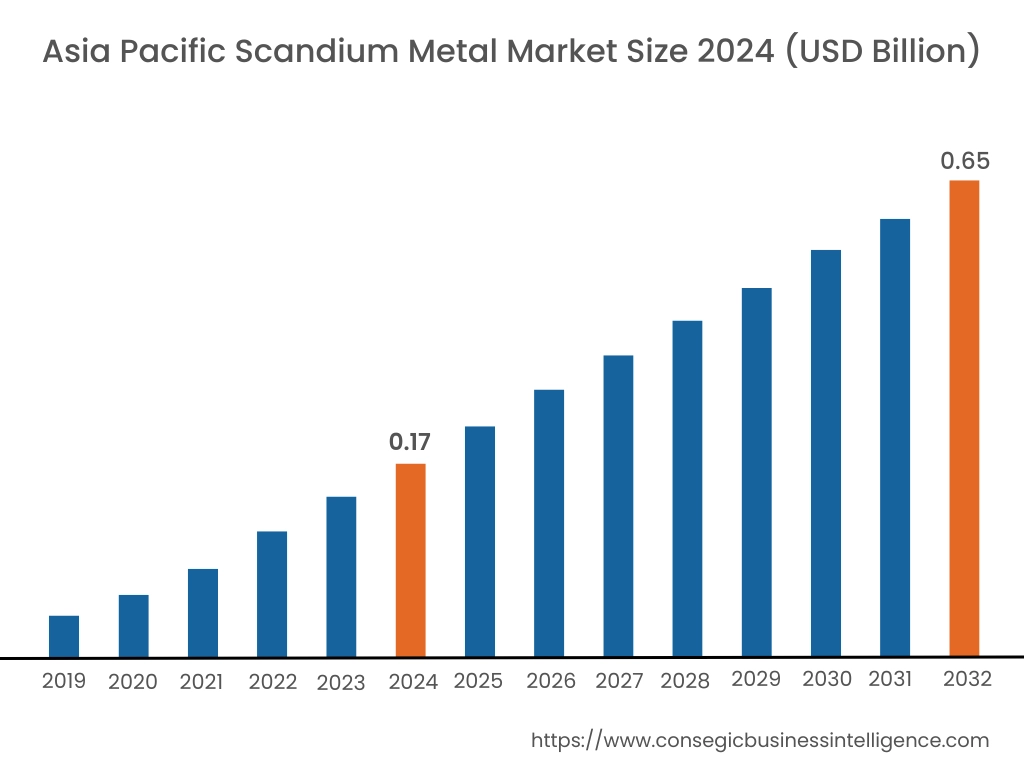
Asia-Pacific region was valued at USD 0.17 Billion in 2024. Moreover, it is projected to grow by USD 0.19 Billion in 2025 and reach over USD 0.65 Billion by 2032. Out of this, China accounted for the maximum revenue share of 46.3%. The Asia-Pacific region is poised for rapid expansion in the scandium metal market, driven by countries such as China, India, and Japan. China, in particular, is the largest producer of rare earth metals, including scandium, benefiting from its rich mineral resources and supportive mining infrastructure. The region's focus on green technologies and renewable energy applications, such as SOFCs, aligns with the increasing utilization of scandium. Furthermore, the aerospace and electronics industries in these countries are incorporating scandium-enhanced materials to improve performance and energy efficiency, presenting significant scandium metal market opportunities.
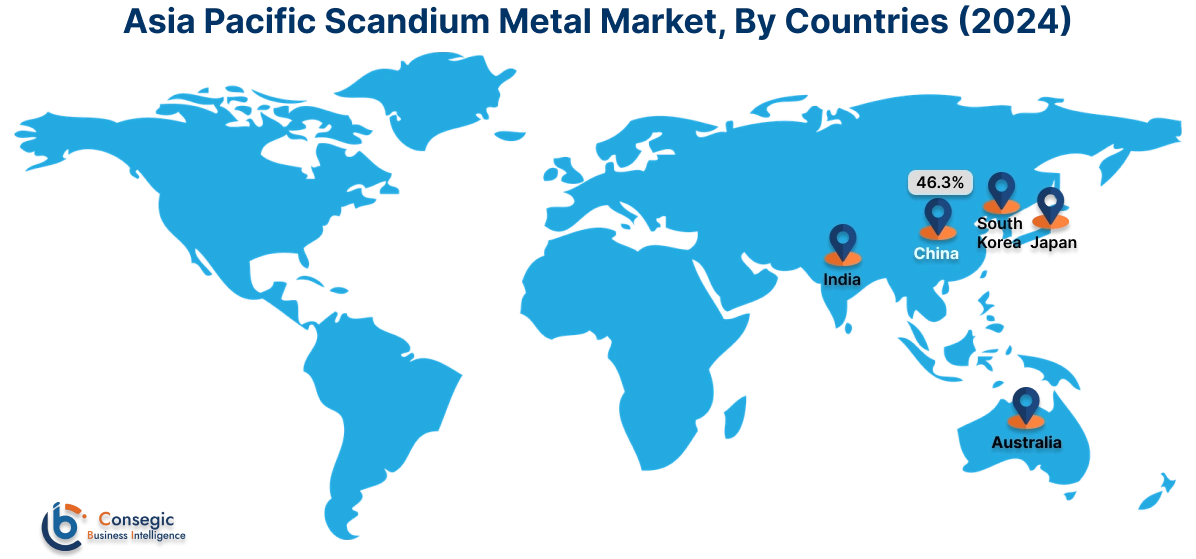
North America is estimated to reach over USD 0.69 Billion by 2032 from a value of USD 0.24 Billion in 2024 and is projected to grow by USD 0.27 Billion in 2025. North America leads the scandium metal industry, bolstered by the presence of several key players. The region's robust aerospace and defense sectors are significant consumers of scandium, particularly in aluminum-scandium alloys used for lightweight, high-strength components. Additionally, the increasing adoption of solid oxide fuel cells (SOFCs) in the automotive sector contributes to the rising demand for scandium. The growing investments and ongoing research into advanced materials further boost the market's growth prospects.
Europe is anticipated to witness substantial growth in scandium metal market trends, propelled by the rising demand for electric vehicles (EVs) and sustainable energy solutions. Germany, as one of the largest producers and consumers of EVs, plays a pivotal role in this market. The European Union's stringent regulations on carbon emissions and emphasis on energy efficiency have led to increased adoption of scandium in various applications, including lightweight alloys for automotive and aerospace components. Additionally, research initiatives focusing on scandium extraction from industrial waste and the development of dedicated scandium mines in countries like Australia are expected to enhance the supply chain and support market growth.
The scandium metal market demand in Latin America is gradually expanding, with countries like Brazil and Mexico exploring its potential applications. The region's growing industrial base and interest in advanced materials present opportunities for market development. However, challenges such as limited awareness, infrastructure constraints, and the high cost of scandium extraction may impede rapid growth. Addressing these challenges through investment in research and development, as well as establishing strategic partnerships, could unlock the region's potential in the scandium market.
As per scandium metal market analysis, the Middle East and Africa region exhibit emerging potential in the market, particularly in countries investing in technological advancements and renewable energy projects. The adoption of scandium-enhanced materials in construction and energy sectors could drive future needs. Nevertheless, economic and political factors, along with the scarcity of scandium resources, may influence the pace of market development. Collaborative efforts to explore and develop scandium extraction technologies, coupled with favorable regulatory frameworks, could enhance the region’s scandium metal market demand.
Top Key Players & Market Share Insights:
The scandium metal market is highly competitive with major players providing products and services to the national and international markets. Key players are adopting several strategies in research and development (R&D), product innovation, and end-user launches to hold a strong position in the global scandium metal market. Key players in the scandium metal industry include -
- Scandium International Mining Corp. (Canada)
- Rusal (Russia)
- Huizhou Top Metal Materials Co., Ltd. (China)
- Hunan Oriental Scandium Co., Ltd. (China)
- Clean TeQ Holdings Limited (Australia)
- Platina Resources Ltd. (Australia)
- Sumitomo Metal Mining Co., Ltd. (Japan)
- NioCorp Development Ltd. (Canada)
- Stanford Advanced Materials (USA)
- Materion Corporation (USA)
Recent Industry Developments :
Product Launches:
- In February 2025, Rusal, the world's leading aluminum producer, established a pilot production facility for scandium oxide with an annual capacity of 1.5 tonnes. The scandium oxide is manufactured from red mud, which is obtained as a by-product of alumina production at the Bogoslovsky Aluminium Smelter, using proprietary technology developed by Rusal.
Partnerships:
- In January 2024, Materion Beryllium & Composites partnered with Liquidmetal Technologies Inc. in a strategic alliance. This partnership will allow the companies to provide their customers high quality products and support services.
Patents:
- In September 2024, Scandium Canada Ltd. filed patent application for aluminium-scandium alloys for 3D printing. The company has developed two such alloys and their powders, for additive manufacturing (3D printing) applications, in collaboration with McMaster University, Canada.
Scandium Metal Market Report Insights:
| Report Attributes | Report Details |
| Study Timeline | 2019-2032 |
| Market Size in 2032 | USD 2.14 Billion |
| CAGR (2025-2032) | 13.9% |
| By Type |
|
| By End-Use Industry |
|
| By Region |
|
| Key Players |
|
| North America | U.S. Canada Mexico |
| Europe | U.K. Germany France Spain Italy Russia Benelux Rest of Europe |
| APAC | China South Korea Japan India Australia ASEAN Rest of Asia-Pacific |
| Middle East and Africa | GCC Turkey South Africa Rest of MEA |
| LATAM | Brazil Argentina Chile Rest of LATAM |
| Report Coverage |
|
Key Questions Answered in the Report
How big is the Scandium Metal Market? +
Scandium Metal Market size is estimated to reach over USD 2.14 Billion by 2032 from a value of USD 0.75 Billion in 2024 and is projected to grow by USD 0.85 Billion in 2025, growing at a CAGR of 13.9% from 2025 to 2032.
What specific segmentation details are covered in the Scandium Metal Market report? +
The Scandium Metal market report includes specific segmentation details for type and end-use industry.
Which is the fastest-growing region in the Scandium Metal Market? +
Asia Pacific is the fastest-growing region in the Scandium metal market. These trends are encouraged by its rich mineral resources and supportive mining infrastructure.
Who are the major players in the Scandium Metal Market? +
The key participants in the Scandium Metal market are Scandium International Mining Corp. (Canada), Rusal (Russia), Huizhou Top Metal Materials Co., Ltd. (China), Hunan Oriental Scandium Co., Ltd. (China), Platina Resources Ltd. (Australia), Sumitomo Metal Mining Co., Ltd. (Japan), NioCorp Development Ltd. (Canada), Stanford Advanced Materials (USA), Materion Corporation (USA) and Clean TeQ Holdings Limited (Australia).
